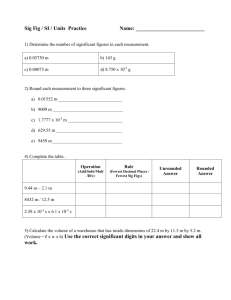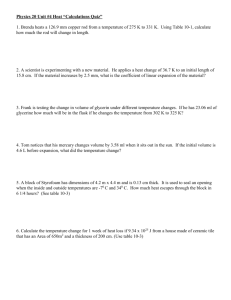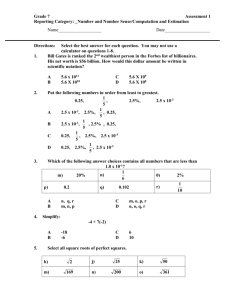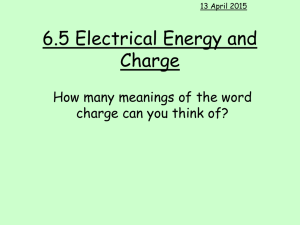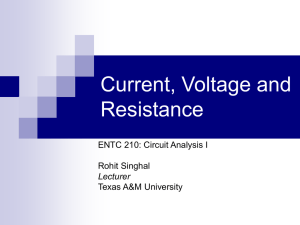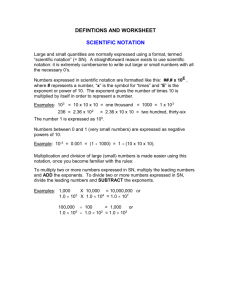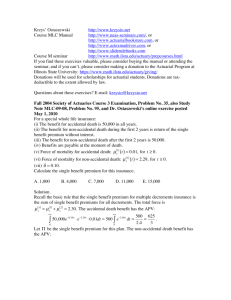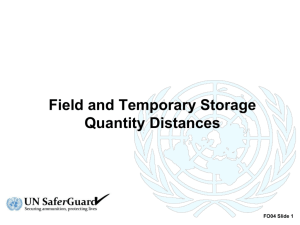File
advertisement
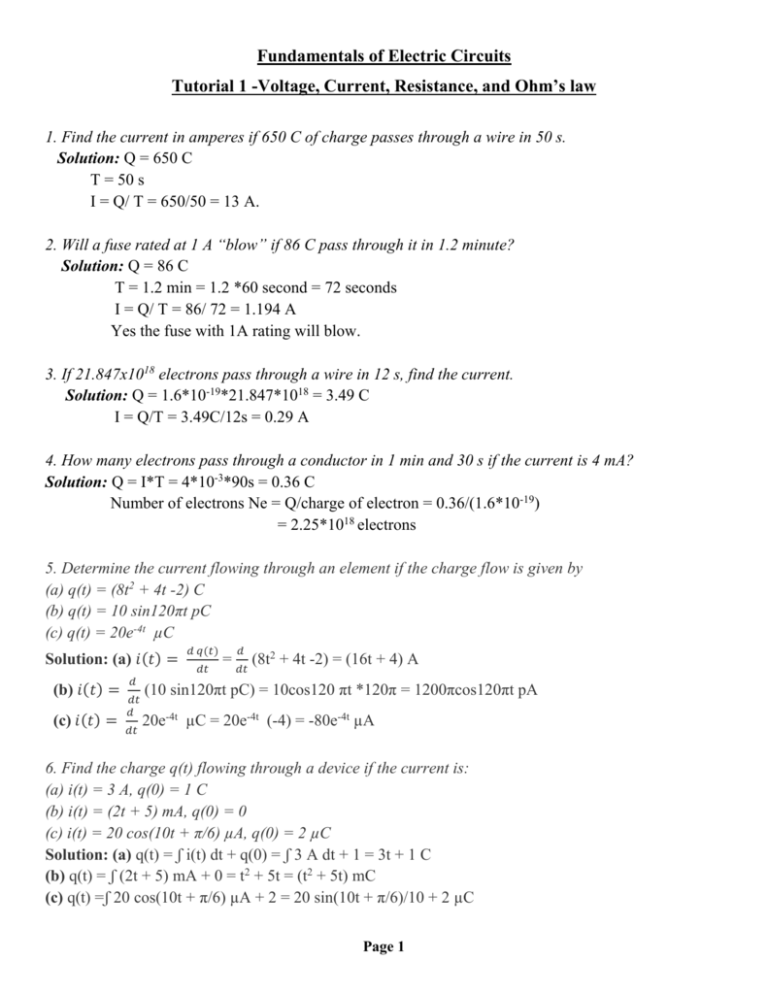
Fundamentals of Electric Circuits Tutorial 1 -Voltage, Current, Resistance, and Ohm’s law 1. Find the current in amperes if 650 C of charge passes through a wire in 50 s. Solution: Q = 650 C T = 50 s I = Q/ T = 650/50 = 13 A. 2. Will a fuse rated at 1 A “blow” if 86 C pass through it in 1.2 minute? Solution: Q = 86 C T = 1.2 min = 1.2 *60 second = 72 seconds I = Q/ T = 86/ 72 = 1.194 A Yes the fuse with 1A rating will blow. 3. If 21.847x1018 electrons pass through a wire in 12 s, find the current. Solution: Q = 1.6*10-19*21.847*1018 = 3.49 C I = Q/T = 3.49C/12s = 0.29 A 4. How many electrons pass through a conductor in 1 min and 30 s if the current is 4 mA? Solution: Q = I*T = 4*10-3*90s = 0.36 C Number of electrons Ne = Q/charge of electron = 0.36/(1.6*10-19) = 2.25*1018 electrons 5. Determine the current flowing through an element if the charge flow is given by (a) q(t) = (8t2 + 4t -2) C (b) q(t) = 10 sin120πt pC (c) q(t) = 20e-4t µC Solution: (a) 𝑖 (𝑡 ) = (b) 𝑖(𝑡 ) = (c) 𝑖 (𝑡 ) = 𝑑 𝑑𝑡 𝑑 𝑑𝑡 𝑑 𝑞(𝑡) 𝑑𝑡 = 𝑑 𝑑𝑡 (8t2 + 4t -2) = (16t + 4) A (10 sin120πt pC) = 10cos120 πt *120π = 1200πcos120πt pA 20e-4t µC = 20e-4t (-4) = -80e-4t µA 6. Find the charge q(t) flowing through a device if the current is: (a) i(t) = 3 A, q(0) = 1 C (b) i(t) = (2t + 5) mA, q(0) = 0 (c) i(t) = 20 cos(10t + π/6) µA, q(0) = 2 µC Solution: (a) q(t) = ʃ i(t) dt + q(0) = ʃ 3 A dt + 1 = 3t + 1 C (b) q(t) = ʃ (2t + 5) mA + 0 = t2 + 5t = (t2 + 5t) mC (c) q(t) =ʃ 20 cos(10t + π/6) µA + 2 = 20 sin(10t + π/6)/10 + 2 µC Page 1 7. The charge entering a certain element is shown in figure. Find the current at: (a) t = 1 ms (b) t = 6 ms (c) t = 10 ms Solution: First find the charge equations using the formulae for the equation of line with coordinates as (0, 0), and (2ms, 80mC) 𝑦 −𝑦 𝑦 − 𝑦1 = 1 2 (𝑥 − 𝑥1 ) q(t) – 0 = 𝑥1 −𝑥2 0−80𝑚𝐶 (t – 0) 0−2𝑚𝑠 q(t) = 40t C, 0 ≤ t ≥ 2 ms q(t) = 80 mC, 2 ms ≤ t ≥ 8 ms 8 ms ≤ t ≥ 12 ms; (8 ms, 80 mC), (12 ms, 0) q(t) – 80 mC = 80𝑚𝐶−0 8𝑚𝑠−12𝑚𝑠 (t – 8 ms) q(t) = 80 m – 20(t – 8m) q(t) = - 20 t + 80 m + 160 m q (t) = - 20 t + 0.24 C, 8 ms ≤ t ≥ 12 ms The charge equations are, q(t) = 40t C, 0 ≤ t ≥ 2 ms q(t) = 80 mC, 2 ms ≤ t ≥ 8 ms q (t) = - 20 t + 0.24 C, 8 ms ≤ t ≥ 12 ms (a) t = 1 ms; i = (b) t = 6 ms; i = 𝑑 𝑑𝑡 𝑑 𝑑𝑡 (c) t = 10 ms; i = 𝑞 (𝑡 ) = 𝑞 (𝑡 ) = 𝑑 𝑑𝑡 𝑞 (𝑡 ) = 𝑑 𝑑𝑡 𝑑 𝑑𝑡 40 𝑡 𝐶 = 40 𝐴 80 𝑚𝐶 = 0 𝐴 𝑑 𝑑𝑡 (−20 𝑡 + 0.24)𝐶 = −20 𝐴 Page 2 8. The current flowing past a point in a device is shown in figure. Calculate the total charge through the point. Solution: equation of line for the points (0,0) and (1,10) is 𝑦1 − 𝑦2 𝑦 − 𝑦1 = (𝑥 − 𝑥1 ) 𝑥1 − 𝑥2 i(t) – 0 = 10𝑚𝐴 −0 1𝑚𝑠−0 (t – 0) i(t) = 10t A , 0≤ t ≥1ms i(t) = 10 mA , 1≤ t ≥2ms 2𝑚𝑠 q(t) = ∫0 1𝑚𝑠 𝑖(𝑡 )𝑑𝑡 =∫0 1𝑚𝑠 = 5 𝑡 2 ∫0 2𝑚𝑠 10t A 𝑑𝑡 + ∫1𝑚𝑠 10 mA 𝑑𝑡 2𝑚𝑠 + 10 𝑚 𝑡 ∫1𝑚𝑠 = 5 [(1 × 10−3 )2 − (0)2 ] + 10 × 10−3 [ 2 × 10−3 − 1 × 10−3 ] = 5 × 10−6 + 10 × 10−3 (1 × 10−3 ) = 15 × 10−6 𝐶 = 15 𝜇𝐶 9. What is the voltage between two points if 96 mJ of energy are required to move 50×1018 electrons between the two points? Solution: Charge of electron = 1.6 × 10-19 coulombs Total charge Q = 50*1018 * 1.6 × 10-19 = 8.01 C Energy required W = 96 mJ Voltage V = W/Q = 96*10-3 J/8.01 C = 12 mV 10. The potential difference between two points in an electric circuit is 24 V. If 0.4 J of energy were dissipated in a period of 5 ms, what would the current be between the two points? Solution: V= 24 V , W = 0.4 J , T = 5 ms = 5*10-3 s V = W/ Q Q = W/ V = 0.4/ 24 = 0.01667 C I = Q/ T = 0.01667/ 5*10-3 = 3.333 A 11. How much charge passes through a radio battery of 9 V if the energy expended is 72 J? Solution: V= 9 V, W = 72 J V = W/ Q Q = W/ V = 72/ 9 = 8 C Page 3 12. A coil consists of 2000 turn of copper wire having a cross-sectional area of 0.08mm2. The mean length pre turn is 80 cm and the ρ = 0.02µΩ.m. Find the resistance of the coil. Solution: N = 2000, ρ = 0.02µΩ.m = ρ = 0.02 x10-6 Ω.m L = N x80 x10-2 m = 2000 x80 x10-2 m = 1600 m A = 0.08mm2 =0.08 x10-6 m2 𝑅= 𝜌𝑙 𝐴 = 0.02 x10−6 x1600 0.08 x10−6 = 400 Ω 13. What is the potential drop across a 6Ω resistor if the current through it is 2.5 A? Solution: V = IR , from ohm's law V = 6Ω*2.5A = 15 V 14. What is the current through a 72 Ω resistor if the voltage drop across it is 12 V? Solution: I = V/R , from ohm's law I = 12V/72Ω = 0.167 A 15. The current through a 4 Ω resistor is 7 mA. What is the power delivered to the resistor? Solution: P = I2R = (7*10-3)2 *4 = 196*10-6 W = 196 µW 16. Refer to the following figure, calculate: a) Current Is b) Voltage VR. c) Power in resistance R. Solution: Is = E/R = 12V/4kΩ = 3 mA VR = E = 12 V P = I*V = 3*10-3 *12V = 36 mW 17. A small, portable black-and-white television draws 0.455 A at 9V. a. What is the power rating of the television? b. What is the internal resistance of the television? c. What is the energy converted in 6 h of typical battery life? Solution: (a) P = I*V = 0.455A*9V = 4.095 W (b) Rin = V/I = 9V/0.455A = 19.78 Ω (c) W = P*t = 4.095W*6*60*60s = 88.452 kJ Page 4 18 a. If a house is supplied with 120 V, 100 A service, find the maximum power capability. b. Can the homeowner safely operate the following loads at the same time? 5 hp motor 3000 W clothes dryer 2400 W electric range 1000 W steam iron c. If all the appliances are used for 2 hours, how much energy is converted in kWh? Solution: (a) maximum power capability P = V*I = 120V*100A = 12000 W (b) Total power used = 5*746 + 3000 + 2400 + 1000 = 10130 W (1 hp = 746W) Owner can use all the mentioned appliances, because total power used is less than maximum power capability. (c) W = P*t = 10130W*2h = 20260 Wh = 20.26 kWh. Page 5

